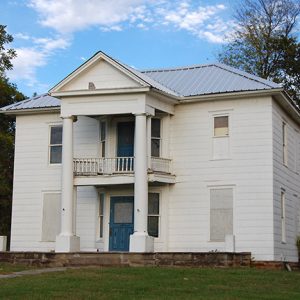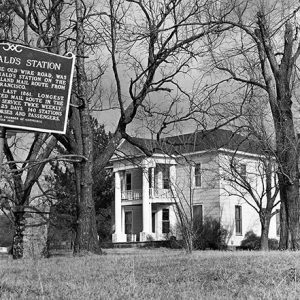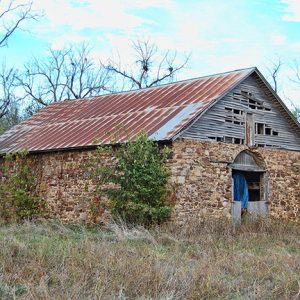calsfoundation@cals.org
Fitzgerald Station and Farmstead
Fitzgerald Station and Farmstead in Springdale (Washington and Benton counties) was added to the National Register of Historic Places on May 27, 2003. Focusing on the time period 1857–1953, the National Register listing includes a barn used by Butterfield’s Overland Mail Company (1858–1861), an 1870s house, a stable, a pump house, a chicken house, a cistern, native stone entry markers, and an outdoor fire pit. Fitzgerald (or Fitzgerald’s) Station and Farmstead has also been designated by the National Park Service as a certified site on the Trail of Tears National Historic Trail.
John Fitzgerald Sr. (1783–1875) and his wife, Mary Fitzgerald (1794–circa 1865), moved their family from Alabama to Washington County, Arkansas, in the late 1820s or early 1830s, settling on a farm northeast of present-day Springdale. The Fitzgeralds were slave owners; the 1850 and 1860 slave censuses list one enslaved female as part of the Fitzgerald household. John Fitzgerald Sr. died in 1875, and in his will, he mentions a former slave, Louisa, who remained with the Fitzgeralds after her emancipation.
The Fitzgerald property was located alongside the Military Road (later called the Wire Road or Telegraph Road), which ran from Springfield, Missouri, to Fort Smith (Sebastian County). The Fitzgeralds took advantage of their location by establishing an inn and tavern on their farm; by the late 1830s, it was a well-known stop for travelers.
The Fitzgerald farmstead was witness to at least two detachments of Cherokee who were being removed—some by treaty, the majority by force—from their ancestral homelands in the southeastern United States to Indian Territory (present-day Oklahoma). The B. B. Cannon detachment (made up of Cherokee who supported the treaty that ceded all Cherokee land east of the Mississippi River to the United States) arrived at Fitzgerald’s on December 25, 1837. The Richard Taylor detachment (made up of Cherokee who opposed the forced relocation) passed by Fitzgerald’s on March 20, 1839, as part of the exodus known today as the Trail of Tears.
From 1858 to 1861, John Butterfield’s Overland Mail Company ran through northwestern Arkansas as part of the route from Tipton, Missouri, to San Francisco, California. Fitzgerald’s inn and tavern became a minor station on the stage route, complete with a stone barn used by Butterfield’s Overland Mail Company. The stone barn still stands in the twenty-first century, one of a handful of original buildings used by Butterfield in existence along the stage route.
During the Civil War, Fitzgerald’s farmstead was a familiar landmark on the Military/Wire Road as soldiers advanced and retreated and civilians fled the war-torn region. Two recorded skirmishes took place near Fitzgerald’s in 1863 and 1864.
John Fitzgerald Sr. sold his farm in 1872. Sometime in the 1870s, a Greek Revival–style home was built on the property, and it still stands there today. A 2004 study by the Arkansas Archeological Survey suggests that the 1870s house may have been built atop the footprint of the original Fitzgerald home and inn.
During the period of Fitzgerald ownership, the farm’s major crop was apples, with orchards covering the rolling fields. Subsequent landowners added vineyards and beef cattle. The property changed hands several times in the 1900s and remained as a working farm until the 1990s.
In 1958, a national commemoration of Butterfield’s Overland Mail Company’s centennial brought renewed attention to the historic Fitzgerald farm and its role in the stage line’s history. The Washington County Historical Society sponsored a program at the Fitzgerald site that included a concert by the Springdale High School band, a tour of the historic barn, the dedication of a historic marker provided by the Springdale Chamber of Commerce, and a costume ball at the Springdale Armory.
In the 1960s, a brick home was built between the barn and the 1870s house. In 2000, the Historic Preservation Alliance of Arkansas added the barn to its “Arkansas’s Most Endangered Places” list. The property remains in private ownership. Local preservation groups have partnered with the owners in recent years to hold public events to raise awareness of the site’s historical significance.
For additional information:
Allen, Dorothy. “John Fitzgerald.” In History of Washington County, Arkansas. Springdale, AR: Shiloh Museum of Ozark History, 1989.
“Fitzgerald Farmstead and Station.” National Register of Historic Places nomination form. On file at Arkansas Historic Preservation Program, Little Rock, Arkansas. Online at http://www.arkansaspreservation.com/National-Register-Listings/PDF/WA0360.nr.pdf (accessed October 22, 2020).
Trail of Tears National Historic Trail. http://www.nps.gov/trte/index.htm (accessed October 22, 2020).
Sanders, Kirby. Driver’s Guide to the Butterfield Overland Mail Route. Springdale, AR: Heritage Trail Partners, 2008.
Webb, Rachel. “Couple Targets Stagecoach Stop for Restoration.” Arkansas Democrat-Gazette, October 7, 2002, p. 1B.
Susan Young
Shiloh Museum of Ozark History
 Post-Reconstruction through the Gilded Age, 1875 through 1900
Post-Reconstruction through the Gilded Age, 1875 through 1900 1870s House
1870s House  1870s House
1870s House  1870s House
1870s House  Fitzgerald Barn
Fitzgerald Barn 




Comments
No comments on this entry yet.